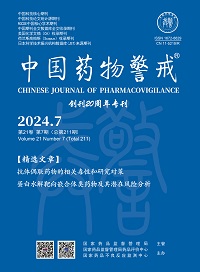|
|
Roles of Yangwei Anshen decoction in improving sleep quality in mouse model of insomnia induced by chronic unpredictable stress
YE Anping, WEI Xue, HUANG Mingyue, ZHANG Xianxie, MA Zengchun, GAO Yue
2024, 21(7):
771-775.
DOI: 10.19803/j.1672-8629.20240014
Objective To explore the effect and mechanism of Yangwei Anshen decoction (YWASD) on sleep quality in insomnia mice induced by chronic unpredictable stress combined with p-chlorophenylalanine (PCPA). Methods A total of 48 ICR mice were randomly divided into six groups with eight mice in each, including the normal control group, model group, positive drug group (diazepam 2.5 mg·kg-1) and high, medium and low doses of YWASD groups (50, 25, 12.5 g·kg-1, equivalent to 18, 9 and 5 times that of the clinical dose for adults). After 14 days of multi-factor stimulation, the ICR mice were intraperitoneally injected with PCPA suspension (30 mg·mL-1) for two consecutive days to establish an insomnia model. ICR mice were treated with diazepam and three different doses of YWASD (12.5, 25, 50 g·kg-1·d-1) for 14 days. Behavioral tests and sleep tests induced by sodium pentobarbital were performed. Serum levels of norepinephrine (NE), 5-hydroxytryptamine (5-HT) and dopamine (DA) were detected with enzyme-linked immunosorbent assay (ELISA) kits. Western blot (WB) was used to detect the expression of 5-HT1A receptor (5-HTR1A). Results Compared with the control group, the mice in the model group had abnormal circadian rhythm and mental state, rough hair, dark hair color, irritability, turbid urine, and slow weight gain. In the elevated plus maze test, the number of open-arm entries and duration of residence of the mice in the model group were significantly reduced (P<0.05). In the open field test, the total distance covered by the model group was significantly reduced (P<0.05), and the time spent on activity in the central area was significantly shortened (P<0.05). The general state and nervous and anxiety-like behaviors of the mice were improved by YWASD. The sleep latency of the mice in the YWASD group was shortened while sleep time was prolonged (P<0.05). In the model group, the content of 5-HT in serum was obviously decreased while those of NE and DA were significantly increased (P<0.01), and the administration of YWASD could regulate the homeostasis of the three neurotransmitters. Compared with the control group, the expression of 5-HTR1A in the hypothalamus of the model group was largely decreased, and the expressions of 5-HTR1A in the middle- and high-dose groups of YWASD were significantly increased. YWASD had the same effect as the positive drug diazepam in terms of sedation and neurotransmitter. Conclusion YWASD has a good hypnotic effect on the model mice induced by PCPA combined with multiple-factor stimulation. In addition, YWASD can improve sleep quality by regulating the levels of neurotransmitters, manifested as reduced sleep latency and extended sleep duration.
References |
Related Articles |
Metrics
|
